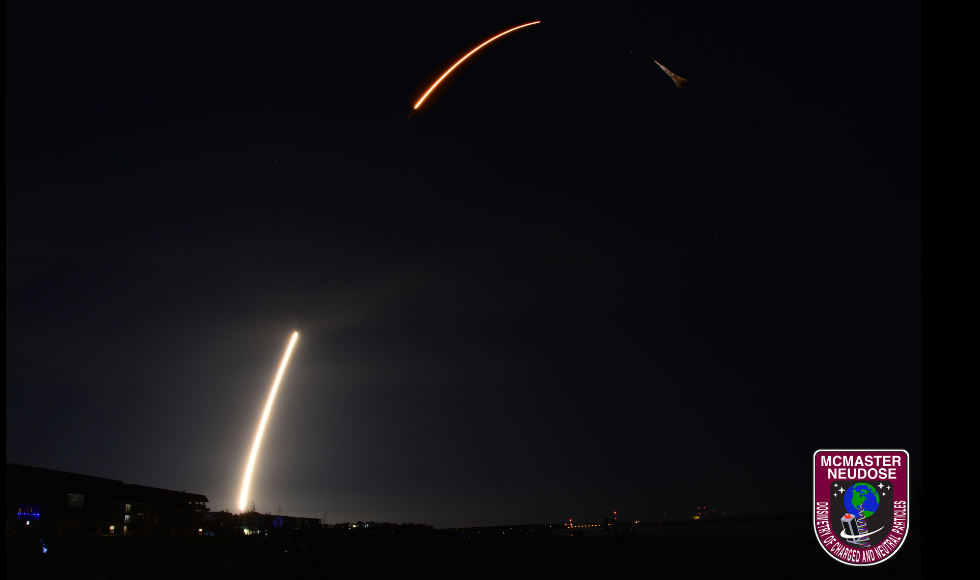McMaster teams up with NASA, SpaceX, CSA for an out-of-this-world learning experience

The SpaceX Falcon 9 rocket blasting off into the night sky after leaving a launchpad at the Kennedy Space Center on March 14, 2023. (Photo credit: Aaron Pitcher)
BY Jesse Dorey
April 4, 2023
For hundreds of McMaster students, researchers and alumni, NASA’s March 14 launch of a SpaceX Falcon 9 rocket was more than just a cargo resupply mission — it was the moment their dreams came true.
On that rocket, bound for the International Space Station (ISS) was NEUDOSE, a state-of-the-art satellite capable of detecting space radiation, built by over 150 McMaster students from across faculties under the guidance of researchers and alumni.
Getting to work on a project of this magnitude with students from such a wide variety of disciplines is a once-in-a-lifetime opportunity, explains NEUDOSE co-Principal Investigator Andrei Hanu.
“Ten years ago, a project like this was completely out of reach for undergraduate students,” Hanu says. “Now, they have the opportunity to experience things that are not traditionally taught in a classroom and get to develop skills that are sought out by industry right now.”
“In a short period of time after graduation, these students will be leaders in the Canadian aerospace industry.”
For these future aerospace leaders — especially team members who travelled to Florida for the big day — the moments leading up to launch were filled with nerves, excitement and reflection.
“We’re all excited and a little bit nervous,” explained Patrick Chin, NEUDOSE mechanical co-lead and mechanical engineering PhD student. “We’re just so grateful to have had this opportunity.”
To pass the time on launch day, the team took a guided tour of the Kennedy Space Center, which included a stop at NASA’s Vehicle Assembly Building and the opportunity to pass by Launch Complex 39A, where the rocket that housed their satellite was strapped in and awaiting launch.

“This is an opportunity that so few get to experience,” said mechanical engineering and society student Angela Tollis, NEUDOSE mechanical co-lead, in the hours before launch. “It’s going to be a very emotional moment that I think all of us will remember for a long time.”
The launch went off without a hitch.
As the SpaceX Falcon 9 rocket blasted off into the night sky, there was a palpable feeling of excitement — and relief — among the NEUDOSE team.
After eight years of long nights, hard work and a lot of caffeine, the moment they had been dreaming of finally became a reality: Their satellite was on its way to space.
Despite all the excitement around him, Jonathan Densil, who is the NEUDOSE mechanical thermal lead and a mechanical engineering and management student, remained focused on the team’s goals.
“Our real mission starts as soon as it gets to the International Space Station, and that’s what we spent all this time building up to. This is the moment of truth.”
In between moments of excitement and relief, applause and joy, the NEUDOSE team reflected on what the project means to them.
For Michael Atali, NEUDOSE drawing specialist and engineering student, working on the satellite was a dream come true.
“I’ve been so grateful that McMaster and the NEUDOSE team have given me this opportunity to achieve some of my childhood dreams of contributing to space. Being down here and seeing it in person, I can’t tell you how many times I got goosebumps.”
Larysa Duda, NEUDOSE payload instrument specialist and medical and biological physics student, had a hard time wrapping her head around what the team had accomplished.
“You couldn’t even dream of having something up in space by the time you’re finishing your undergrad. Just to have something in space with my name on it at this point in my life is really crazy.”
And for Christos Liaconis, a mechanical engineering graduate who worked on the NEUDOSE team while studying at McMaster, the project changed the entire course of his career.
“NEUDOSE proved to me that being an aerospace engineer or working in the space industry can be more than just a childhood dream. I didn’t realize how many opportunities there were in the Canadian aerospace industry, and this opened all those doors for me.”
More on McMaster’s first space mission:
McMaster satellite lifts off from Kennedy Space Center
Meet the team that built McMaster’s first satellite
Ask a McMaster expert: How does the NEUDOSE satellite work?
Why study space radiation? To keep astronauts safe
Shooting for the stars: How a team of researchers and students built McMaster’s first space mission


